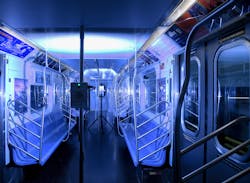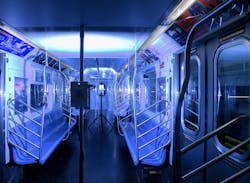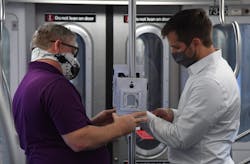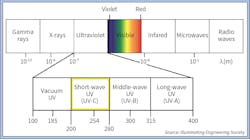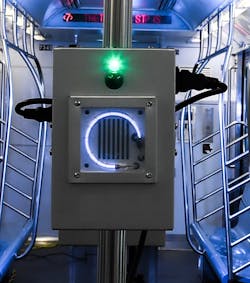As COVID-19 sidelines many businesses, the demand for building lighting has dimmed. After all, there’s no need for lights in padlocked stores, restaurants, entertainment venues, and the like. That means more than a few electrical contractors likely have had to shelve or cancel lighting upgrades for clients experiencing a sharp slowdown in business and facing an uncertain future.
Nevertheless, there is one area of specialized lighting that could be poised for growth as a direct consequence of the pandemic. It’s called germicidal ultraviolet (GUV), an interior lighting application that produces invisible UV light capable of quickly destroying air- and surface-borne bacteria, fungi, and viruses, depending on the type of light used and the delivery mode.
A proven technology with a long history, GUV has seen growing uptake, especially in health care settings. Now it’s experiencing a spike in broader interest as a possible weapon to combat the spread of COVID-19 where people gather and as a ready line of defense against future infectious disease outbreaks.
Predictably, though, the excitement building around GUV carries the potential for confusion, some of it consequential. Improperly designed, specified, or deployed solutions wrongly billed as GUV might fail to meet a strict definition critical to effective and safe use.
A narrow spectral band of short-wave ultraviolet light dubbed UVC, generally between 200 and 280 nanometers (nm) in wavelength with a “sweet spot” at 256 nm, delivers the most potent disinfection power while also minimizing the potential for those coming into contact with it to suffer UV-caused skin burns and eye damage. Longer-wave UV light — UVB from 280 nm to 315 nm, and UVA from 315 nm to 400 nm — is considered less efficient in pathogen destruction and carries elevated health risks from exposure. All GUV, including predominant UVC, however, has generally been deployed so human contact with UV light energy is limited either by complete avoidance or intense mitigation.
A yellow light
Lighting marketers clearly smell opportunity presented by COVID-19 — and that carries some risk associated with overhyped and untested products, spotty familiarity with the technology, faulty installation, and improper utilization guidelines. That has experts worried about GUV safety and effectiveness waving caution flags. One that weighed in is the Illuminating Engineering Society (IES), whose photobiology committee issued a comprehensive report on the technology, emphasizing the importance of a sound understanding of it and careful product selection, solution design, and installation. It characterizes GUV, in its various and differentiated applications and delivery formats, as a not-well-understood product that can be highly effective and generally safe if guidelines are closely followed.
Discussing one common method of deployment, in which ceiling-mounted UVC fixtures continuously disinfect circulating upper-room air, the report notes: “Upper-room GUV air disinfection is a primary means of safe and highly effective air disinfection, provided it is planned, installed, commissioned, and maintained according to current international standards,” but adds that to get it right, “a knowledgeable consultant is recommended.”
It indicates, though, that lamp emissions pose a workplace safety and health hazard to the eyes and skin if lamps are improperly installed or used. “However, these lamps can be used safely if workers are informed regarding the hazards and follow appropriate precautions,” the report says. “Upper-room GUV has been safely used for preventing airborne transmission for at least 70 years.”
Still, safety concerns are valid, the IES report says, and they constitute a possible barrier to wider use of GUV at a time when it could make a difference. For contractors, understanding how to safely deploy it — and assuring potential customers of that knowledge — will be key to seizing new market opportunities.
“The 2014 outbreak of the Ebola virus and the recent spread of the novel coronavirus disease 2019 have renewed interest in GUV lamps for disinfection,” the report notes. “More-widespread use of GUV is often limited by safety concerns, but these are manageable and minor compared to potential infection prevention.”
With research seeming to confirm that GUV can inactivate the COVID-19 virus, it is sure to attract more interest the longer the pandemic persists, says William P. Bahnfleth, Ph.D., a professor of architectural engineering at Penn State and an indoor air expert who has studied GUV. In an IES webinar, Bahnfleth notes it has begun to pique the interest of businesses and building owners who want to be proactive in ending the pandemic and encouraging people to return to the public square.
“There is some good potential to help develop a sense of security for people to go back into buildings, to both be safe and feel safe,” he says. “It’s a potentially cost-effective adjunct to baseline levels of filtration and ventilation we need in buildings, and it can be used to disinfect surfaces. It can be applied in some form in most facilities.”
Hospitals, nursing homes, and other medical-related facilities are likely to see the most activity in any new-installation wave, he says, but fresh demand could also emerge in the hospitality, food service, retail, transportation, and education sectors struggling to reopen and prepare for what might be a changed world. “We’re now learning that we need to think about infection control in all types of buildings because those equipped to protect us could have a role in stopping future epidemics,” he says.
New deployments
A blossoming proactive stance is already in evidence across a range of sectors — from education to transportation to retail.
KIPP DC, a charter school network in Washington, D.C., is reportedly planning to install UVC lighting inside building air handling units — one distinct method of GUV air disinfection — on one campus, and it is considering extending that approach by possibly adding air duct-sited UVC lighting to its other six campuses ahead of the fall semester. A Washington Post story quoted Raj Setty, a principal at Washington, D.C.-based consulting engineering firm Setty and Associates, which is advising KIPP DC, as saying UV-C might complement circulating-air filtration techniques.
“Every 10 minutes…we’d like the air to touch a filter, or get diluted, or start to hit an electronic (device),” he was quoted as saying.
In New York City, the Metropolitan Transit Authority (MTA) in May began a pilot test using GUV inside part of its fleet of rail and subway cars, buses, as well as some facilities, as part of a multifaceted COVID-19 disinfection effort. The test has involved deploying several hundred mobile, pulsed UV light-emitting fixtures, placing them inside vehicles and facilities when not in use, and programming them with motion sensors to shut down when spaces are occupied. The units, which MTA moves around the system on a schedule, emit bursts of full-spectrum UV light — a blend of safer UVC as well as more dangerous UVA and UVB — necessitating operation that keeps people away from the light.
MTA was spurred to roll out the program by New York’s Columbia University Center for Biological Research, which has been digging into understanding GUV lighting’s impact on the COVID-19 virus. MTA, in a press release, says the center’s director, David Brenner, led a test of the performance of the type of miniaturized UV lamp product being utilized and concluded it would be effective in a COVID-19 infection control role. In mid-June, the agency announced it was expanding the test to include complete train sets, evidence that early results were encouraging. In the release, it says, “ultraviolet technology is one of many outside-the-box ideas we’re pursuing to disinfect the system,” and that further expansion of the pilot is possible.
New York City is also the site of another pandemic-inspired rollout — this one permitting higher human UV exposure. In May, Magnolia Bakery announced it was installing UV lighting at a Manhattan e-commerce production facility and two retail stores there. The three-pronged approach includes a walkthrough arch at the production facility entrance that emits UVC in 20-second or greater doses as personnel enter and exit; a UVC downlight at the production facility and the stores targeting viruses and bacteria on surfaces and in the air; and air-sanitizing troffers at production and retail sites combining fixtures that expose HEPA-carbon filtered air to UVC and UVA, eliminating a variety of airborne pathogens.
A sweet spot
What makes the lighting different is that it employs a specific wavelength of UVC light, dubbed far-UVC, that a growing body of research suggests is safe enough for human exposure and has highly effective GUV action. It’s UV light in a narrow range on the shorter end of the wavelength scale for UVC — roughly between 205 nm and 230 nm, a range that more lighting manufacturers may try to target in new product development (see Figure above). The product being used by Magnolia delivers 222-nm UV that the manufacturer, Healthe, claims on its website “effectively penetrates and inactivates air and surface microbes and is safe for human exposure.”
If substantiated, those dual qualities, Bahnfleth says, give far-UVC an opportunity to usher in the next generation of germicidal lighting products that can be installed and operated more freely in occupied spaces.
“UV lamps with 256 light are the standard now, and that provides a pretty high fraction of the peak germicidal power of 265,” he says. “But 220 is fairly high itself and offers some good qualities that may mean it’s used more in the future.”
IES, however, is more skeptical that it can be used differently than other types of UVC. It maintains that research is inconclusive. “Far-UVC lamps that emit around 222 nm can pose a hazard to the cornea, and recent studies have been inconsistent regarding whether far-UVC lamps pose a significant skin hazard,” the report states.
Columbia’s Brenner, though, has conducted extensive studies on far-UVC and has become increasingly convinced of its safety. In a story posted on Columbia University’s website in April, Brenner, a professor of radiation biophysics, explained that tests indicate low doses of this shorter wavelength UV aren’t powerful enough to penetrate either the skin’s dead-cell layer or deep enough into the eye to cause damage. That means far-UVC has the potential to be a “game-changer,” he says, since it could conceivably be safely used in a range of public places in an overhead lamp configuration.
However, lack of full consensus on the safety of far-UVC is a prime example of the confusion that could begin to seep into a GUV market that could be ripe for growth. The danger lies in products rushed to market and billed as safe or qualified-safe, depending on following installation and operational guidelines. If concerns begin to mount around safety (as well as effectiveness), wider deployment of GUV could stall.
Another example of the push to broaden the scope of marketable GUV solutions is evident in expanding research into pushing LED lighting into a broader germicidal role, possibly even as an eventual coronavirus disinfection tool. That would be a major departure from prevailing GUV technology, which comprises non-fluorescent coated low- and medium-pressure mercury discharge lamps and pulsed xenon arc lamps. LEDs that emit UVC in the potentially effective 220-nm to 270-nm range are “experimental” at this point, according to IES, but face some efficiency, cost, and scalability hurdles. Bahnfleth, though, sees developers working to overcome them.
“LED will eventually displace mercury vapor lamps for germicidal applications just as they have for illumination,” he says. “Their configuration flexibility, the ability to customize wavelengths, dimmability, and performance in thermally challenging environments means they have a future. I believe they’ll eventually have a major impact on this market.”
That’s a market bubbling with excitement and opportunity amidst a pandemic demanding creative and aggressive solutions. GUV — with its ability to work silently, reliably, and, in time perhaps, more safely than ever — has the potential to become an important tool in a biological line of defense that will need to be fortified and readied for a future that COVID-19 might be glimpsing. The immediate challenge for lighting contractors pursuing new GUV opportunities may be to tread slowly and carefully. Moving too fast, without a solid base of knowledge in an application quite different from illumination, could carry unaccustomed risks for contractors and their customers. Amid a pandemic that is still playing out, less risk sounds about right.
Zind is a freelance writer based in Lees Summit, Mo. He can be reached at [email protected].
About the Author
Tom Zind
Freelance Writer
Zind is a freelance writer based in Lee’s Summit, Mo. He can be reached at [email protected].
